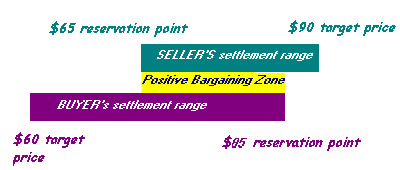
|
Distributive Bargaining
By definition, it is zero sum--when I win, you lose. Even in more complex multi-issue, multi-party, or interest-based negotiations, there is nearly always a portion of the issues on the table that concern the distribution of fixed resources. Basic Terms
Target or aspiration point-- your ideal outcome. Dolores' is $60, Benjamin's is $90.BATNA -- Best Alternative to a Negotiated AgreementWhat do you do if you can't reach an acceptable deal? Dolores' BATNA is to share a text with her roommate. Benjamin's is to wait and see if a more generous buyer shows up or to sell the text to the bookstore. The BATNA is a positive perspective that focuses on your options.Reservation point-- The point beyond which you will not accept a deal and will turn to your BATNA. The reservation point is the quantification of BATNA, the trigger point where you will take your next best alternative instead of negotiating. (Informally, this is often called "your bottom line.") Dolores' reservation point is $85, Benjamin's is $65.Bargaining Zone-- the range between the buyer's high and the seller's low. In this case between $65 and $85. This is a positive bargaining zone. A negative zone occurs when there is no overlap (say Benjamin would only sell for $90 or more, and Dolores wouldn't go higher than $85. BATNA time!) Bargaining surplus-- a measure of how wide the positive zone is -- in this case $20, which gives a relatively large area for mutually successful bargaining.Negotiator's surplus-- The amount of the positive bargaining zone a negotiator takes home. For Dolores it is $85-$80=$5. For Benjamin it is $80-$65=$15.Suboptimal deals or "leaving money on the table"-- When parties fail to capitalize on a positive bargaining zone where both sides could have met their goals, or miss other opportunities for mutual gain. In this case, the bargaining zone is large enough that even incompetent negotiators will probably find a price within it. If the zone is quite small, however, (Say Dolores has the option of a $70 edition with slightly more marks on it.) the negotiators may decide erroneously that there's no way they can reach agreement. Don't confuse this term with your disappointment in not capturing the entire bargaining surplus for yourself!Split the difference. Arriving at a deal that is halfway between the positions of each party. In this case, Ben asks $90, Delores counters with $70, and they split the $20 difference at $80. Statistically most deals end close to the midpoint of the initial proposals (anchoring effect), however wise negotiators only invoke this norm when it gives them a good deal.TangiblesBefore you negotiate, consider which issues and outcomes are tangible. These are more likely to require some kind of distributional decisions. Some examples:
IntangiblesIntangibles can be just as important when you are thinking about negotiation outcomes. These tend to be indirectly negotiated (shadow negotiation, which we discuss later) or require pie-enlarging and creative resolution strategies. Some examples of intangible issues:
Wise allocation of resources and 12 Strategies for getting a good slice of the pie are discussed on the next page. |